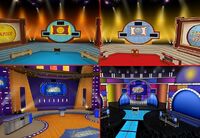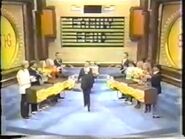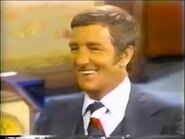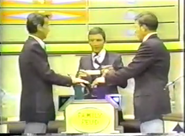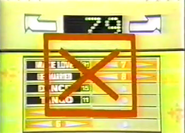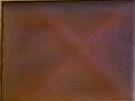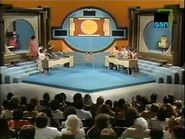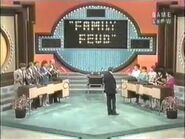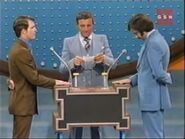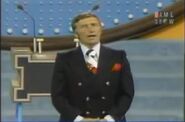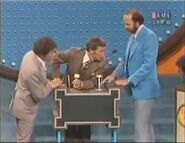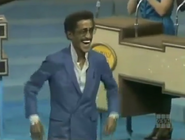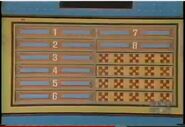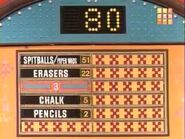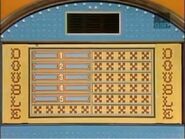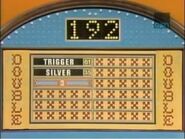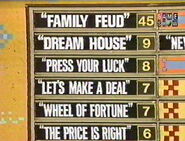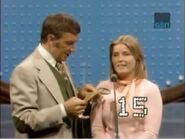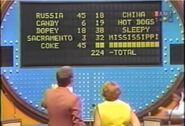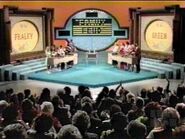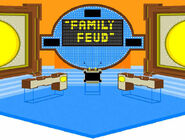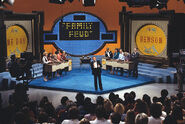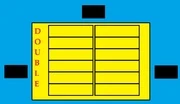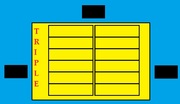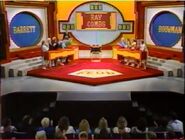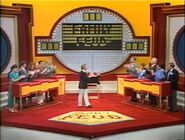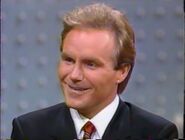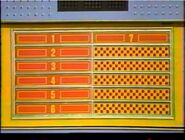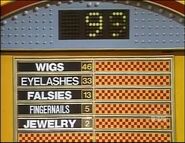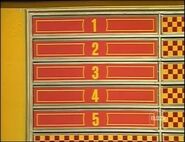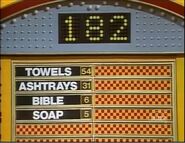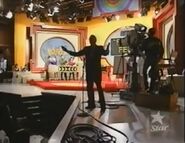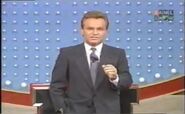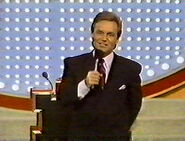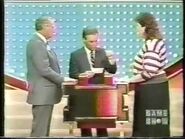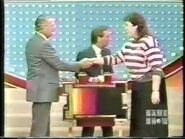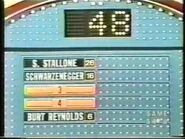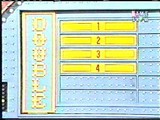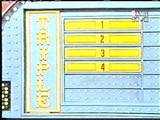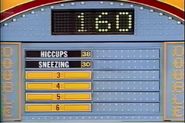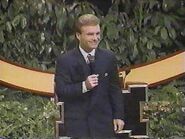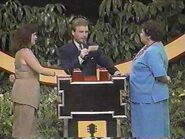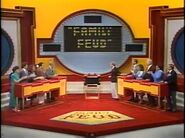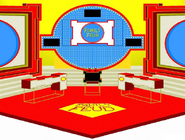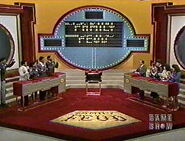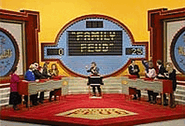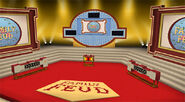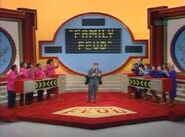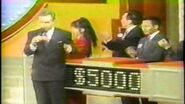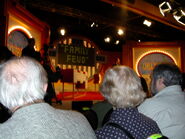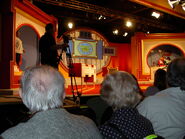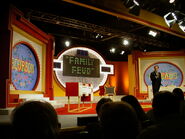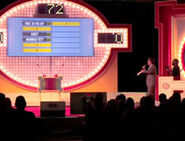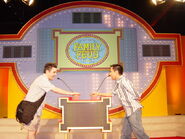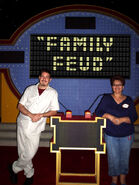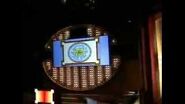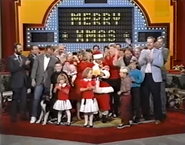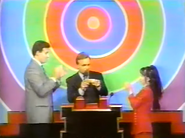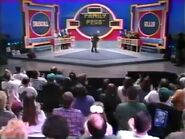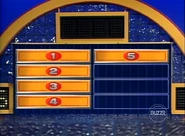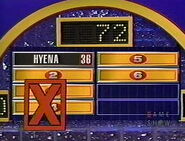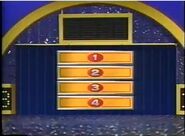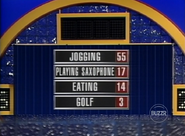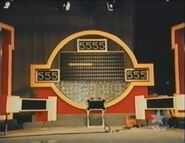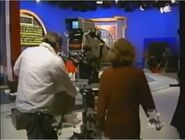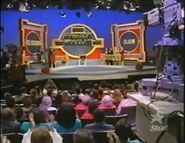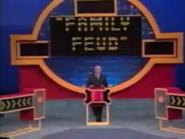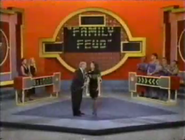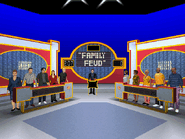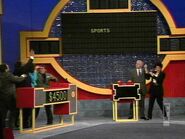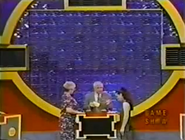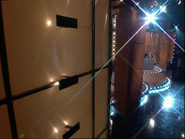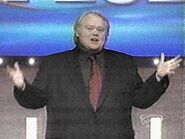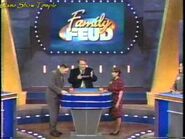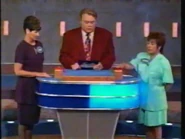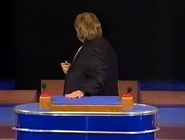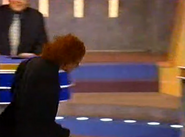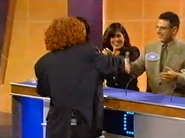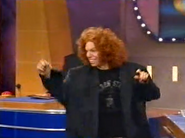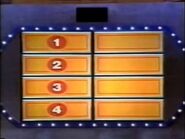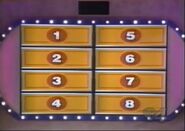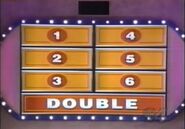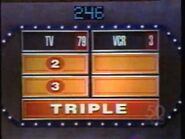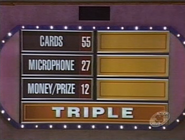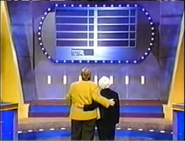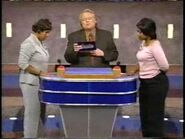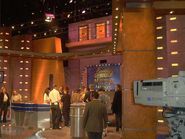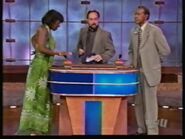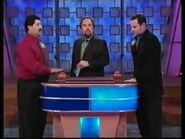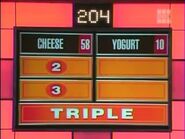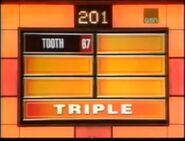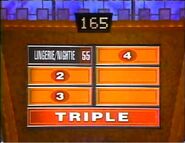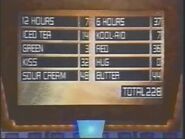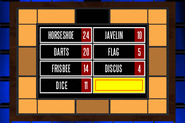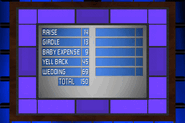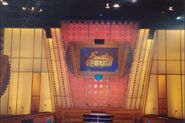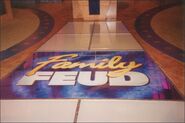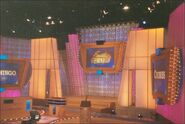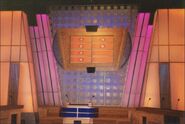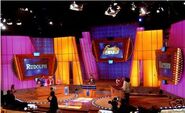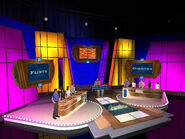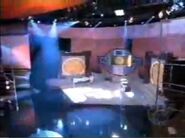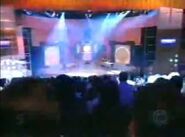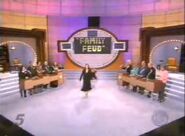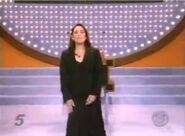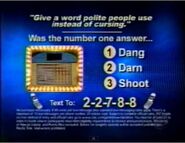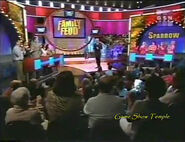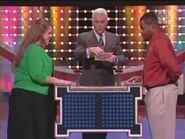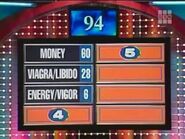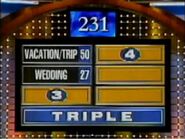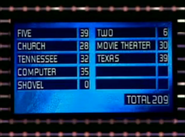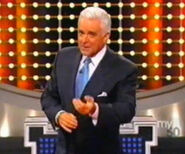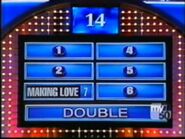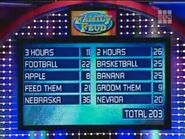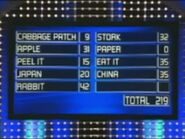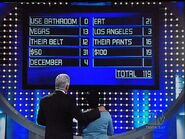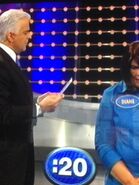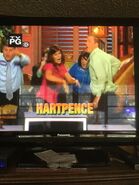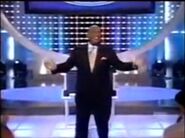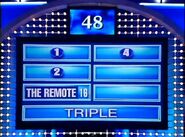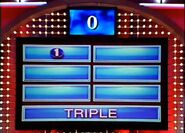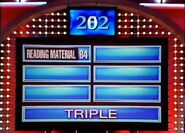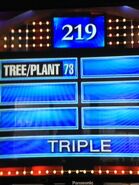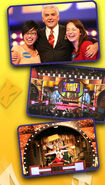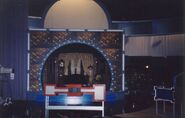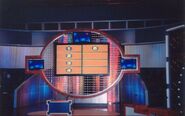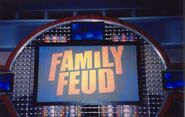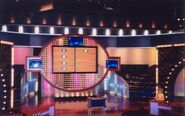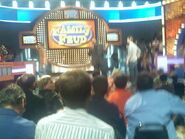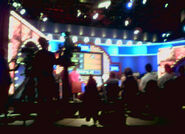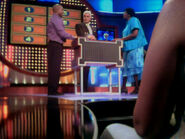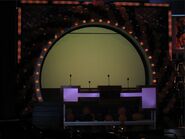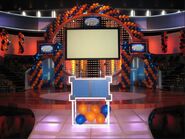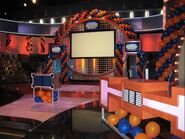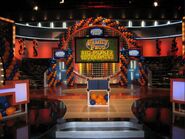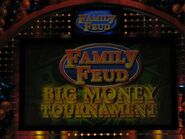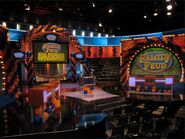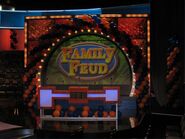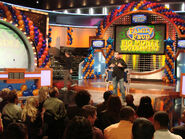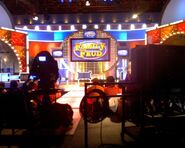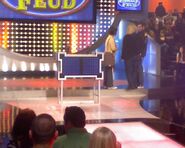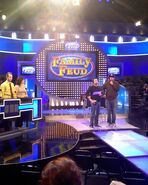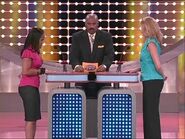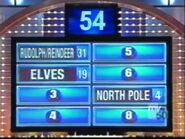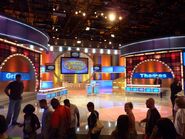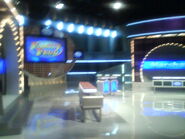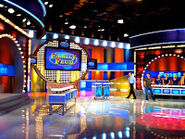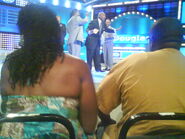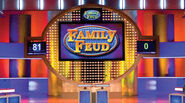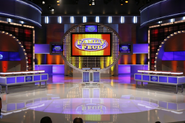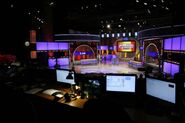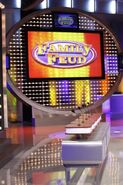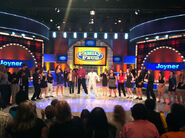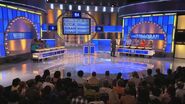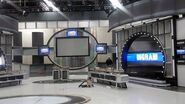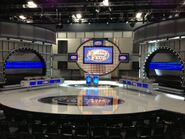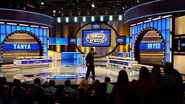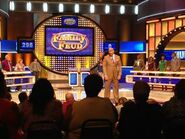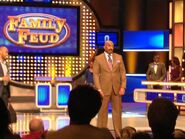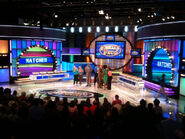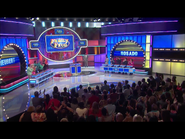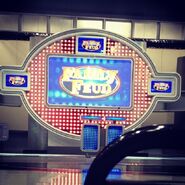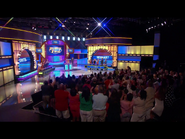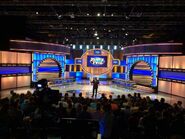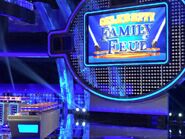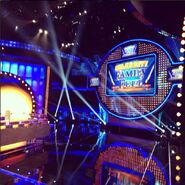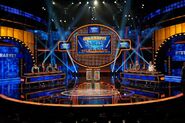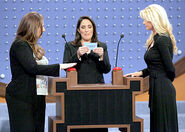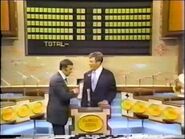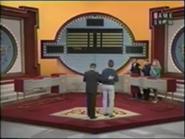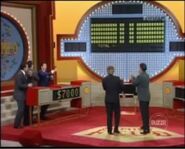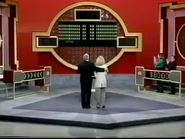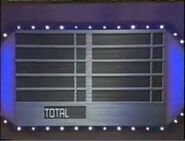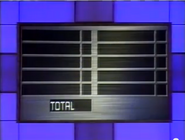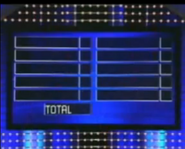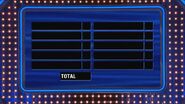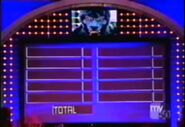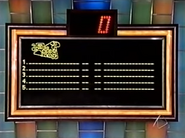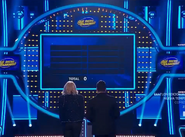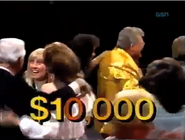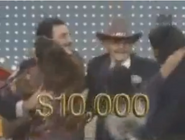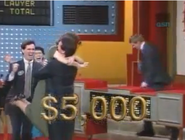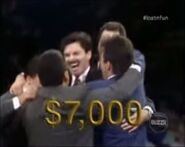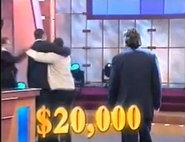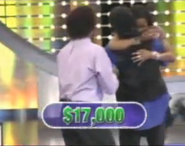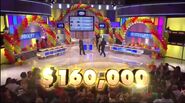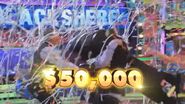SURVEY SAYS!.....Welcome to the Family Feud Sets page. These are the pictures & artworks of the many sets of Family Feud over the years. This also contains information about the sets.
The Gameboard and other parts of the Set[]
The Original Board[]
For a span of the first 20 years, Family Feud used a trilon game board. Two sides of the board had twelve flip panels (six in each column) used for revealing answers during the main game (though no question ever had 11 or 12 answers, the most was 10), one of those sides was covered up by the show's logo during the opening and was taken down backstage when the opening was finished, and the words "DOUBLE" & "TRIPLE" were placed on both sides of the main game board to indicate that the values were either doubled or tripled, and the third was a digital board which displayed the show's title and was used for Fast Money. During the opening and sometimes closing of the show, the digital board had an animated light pattern: The original Dawson series had its board light up/turn off one row at a time, while the 1988-1994 series had their board light up/turn off in a "four square-like" manner. This was not used for the closing of the 1988-1994 series (except for Christmas episodes, which alternated between the show's title and "MERRY XMAS" with stars on both sides of "XMAS"), but was used for the closing of the 1994-1995 series. For most of the series, the digital board in neutral title mode was displayed in yellow on black, but in the pilot and in the early episodes of the Combs run, the board displayed black on yellow.
Alterations[]
All Versions: In the 1975 pilot, the trilon board was housed in a box-like shape, with all three numerical displays (the bank & family's scores) up top. Under the board were three little boxes which were used to display the strikes. The number sides of the flip panels had the numbers sandwiched between 2 triangles. They were similar to that of Match Game, the show that gave us Family Feud, and the unplayed panels were tan with a pale blue circle in them. When the show became a series in 1976 and lasting until 1994, the trilon board was now housed inside the now familiar blue oval with rectangles sticking out of either side to make room for the family's scoreboards (the bank was still at the top as it had always been; plus, the strikes were now superimposed). The oval board has chasing lights which lit up from the center to the ends; one of the top sides would light up when a family won the round and the entire side would light up when a family has won the game. While the Dawson shows always had their lights turned off, the Combs shows turned on theirs when it was time to play Fast Money and continued to have them turned on during the final segment of the show.
The Dawson Years: Dawson's main game board sides were completely yellow. The number sides of the answer panels were orange and they had a blue boxy shape the same as the opening logo, family backdrops & face-off podium with the numbers in the middle. The neutral panels had red checkerboard-like symbols on them. The opening logo was the red boxy shape with Family Feud in the same color in a yellow oval. The chasing lights did not flash in synchronization, even though the family name panel and show's logo panel's oval lights did. Also, the face-off podium's lights not only flashed when buzzing in during the main game, but they would flash when a family won the game, and both would flash during the show's open, close, and if a family won Fast Money. The original buzzers were plunger-type, but on an episode aired in 1977, during the last face-off, the left person tried to buzz in and broke the buzzer before the right person buzzed in. After the right person answered and saw if it was on the board or not, Richard took the buzzer off the podium and explained what had happened. To combat this problem, this was changed to the more blocky-shaped buttons. The original family podiums had bronze microphones; when the show switched studios after five weeks, the contestant microphones became silver.
The Combs Pilot: Combs' set is mostly the same as the series except that the main game board sides were still yellow. The number side of the answer panels were red with yellow outlines & numbers. The opening logo was the same; plus, there was an additional boxy shape covering with Ray's name on it. Also, the family podiums were red & yellow and all three displays lit in yellow during the opening of the show. Finally, a different clang was used for revealing answers in the main game.
The Combs Years: Combs' main game board sides completely blended into the board. The number side of the answer panels were now in traditional yellow with red outlines & numbers. The opening logo was now the red & white boxy shape with Family Feud in gold in a red & blue oval. While the first Dawson era had the Fast Money answer reveals remain silent and scoring zero on the first question left the TOTAL blank, the Combs era adopted a sound originally used on Trivia Trap (which ironically used the last few notes of the show's signature theme song) for their revealings of the Fast Money answers and it has stuck out ever since, and scoring zero on the first question showed up as such in the TOTAL. Unlike the chasing lights on Dawson's board, the lights on Combs' board did flash in synchronization, thanks to some additional lights. When the chasing lights reached the scoreboards, the family name panel and show logo panel lights would light up. The chasing lights also occurred when a player buzzed in during the main game, and the face-off podium now had rainbow lights to indicate who buzzed in first. During the regular series in 1992, and the Family Feud Challenge/New Family Feud era, there were "strike" signs at each family's podium, each consisting of a black stick with a white card with the Strike Indicator on it. Whichever member caused the team to get a strike would be given a sign to hold; thus there were three signs to signify the three strikes. In addition, the bank was expanded to four digits.
NOTE: In the special Opryland episodes, Only the Ferranti-Packard part of the board used for Fast Money was used for all rounds. The survey answers would be displayed as numbered lines with the total underneath, and would sweep to reveal the correct answer with the clang sound when a correct answer was given. A similar layout would later be used on ¿Que Dice la Gente? in 2006. The Bullseye round was played with CGI graphics superimposed over the board instead of the Bullseye prop descending down.
Dawson's Return: When Richard Dawson returned to the show in 1994, the oval board was completely overhauled like the rest of the set; for now they replaced lights with glass panels, the border was yellow, and the bank & scoring displays had a yellow border, too (and still had four digits). Plus, the trilon was replaced with a steady digital board; because of this and just like the UK version of Family Feud (Family Fortunes), the digital board now did all jobs which were to hide & display answers in the main game & Fast Money, but that's for the people in the studio. For the home viewers during the main game only, the board was covered up by computer graphics; the Bankroll round had the board covered by more glass panels and an oval displaying the dollar values and the answers. The main rounds saw the digital board covered by the familiar flip panels, only now the numbers were white inside red ovals, the slots that were not in play were replaced with white outline boxes, and there was now only room for eight answers (four in each column) instead of 12. While the majority of questions had two columns of answers, on questions consisting of three or four answers there was only one column, and all answers were shown in the center of the board. When a round ended the show's title would return to the board, and all changes occurred off-camera. The set's backdrop would be blue during the opening and main game, would switch to red for Fast Money, and then switch back to blue for the closing (just as Jeopardy! did during the first season of the "Sushi Bar" set era). This particular board was first used when the show was taping in Opryland, Tennessee with Ray Combs still hosting, but the only graphics used were that of the Bullseye round since the show couldn't bring the big prop used for the Bullseye game with them. For Fast Money, some answers were marked with asterisks; the asterisk indicates that the player’s answer was specific and belonged to a broader category.
Today's Board[]
When the show returned in 1999 after a four year hiatus and to keep up with the times, the trilon/digital board was replaced with a single TV monitor which (like the digital board in the 1994-1995 run) did all jobs. The bank display returned to holding three digits until 2010, when all displays became computerized. The main game board still held eight answers and the number sides still had the same look from before. The unplayed slots were the same, but they just don't have numbers on them; from 1999 to 2010, the bottom two slots were replaced with one large slot with the word "DOUBLE" or "TRIPLE" on it to indicate affection of the values; these days only the sudden death question had the large "TRIPLE" slot below since there was only one answer needed to be given. The Fast Money board is completely computer-animated: it has ten black slots to house the answers & ten black squares on the right to house the point scores (the scores next to the right side answers on the original versions used to be on the left), and one additional slot for the total scores. For individual reveals, a red square was used to reveal the answers and ending up in the point square and it accompanies the now familiar reveal sound; the square disappeared when the value was revealed. While the face-off podium was seen for the entire show in the past, for the current era, it would be removed for the remainder of the show.
Alterations[]
Anderson Era: When Louie Anderson was the host, the monitor was a projection TV monitor housed inside an oval-like square with chase lights on it. It was located on a wall which doubled as an opening for host Anderson to go through. Not only that, the bank was now in blue eggcrate mode (the toteboards used to be in a Ferranti-Packard font), while the family's scoring displays in the same font were now shown on their podiums; their names would be seen on small TV monitors above them that were extremely difficult to see with wide-shot views of the set. On occasion coming out of the first commercial break, the Uproar Survey question was instantly replayed on the game board's monitor before it flipped back over with the "clang" from the front game prior to Round 2. The winning family's celebration was instantly replayed on their monitor before it flipped back over with the "clang" from the front game prior to Fast Money. For the final season of this run and continuing into Karn's run, the show's logo would be seen on the floor, similar to Combs' run. When Fast Money started the clock reading 20/25 in seconds with a colon on the left would appear by fading in on early episodes. Now it pops in quickly.
Karn's Era: For the first four years of Richard Karn's tenure, the monitor was housed inside a square-filled rectangle, with the bank inside the top square but the font was now peach (the same as the family podium scoreboards). The rectangle was in two colors, peach & blue: the peach rectangle was used for the main game, and the blue one was used for Fast Money. For Fast Money itself, the top square would be covered. In Richard Karn's final season, the board now resembled more of Louie Anderson's board except that there was now a trapezoid housing the board on it. Also in the last two years of Karn's run, the background of the board was changed from metallic silver to rusty gold. The Fast Money clock design hadn't changed but when the countdown starts, background music plays.
Gameshow Marathon/Lake Era: The set was made to replicate the Dawson version from the 70's, though with more modern features such as a television monitor replacing the trilon. The font with the team name was slightly different, too. Other notable features included a sound effect reminiscent of the mechanical board when a correct answer was given. Also, just like its original 1976-85 incarnation, the "blip" sound effect when an answer was shown in Fast Money was absent in this version.
O'Hurley/Roker Era: Starting in 2006 and to celebrate the show's 30th anniversary, the show went back to its roots and revived the familiar oval-shaped chase light board and boxed-shape Face-Off buzz-in podiums, but the TV monitor was still used; even the bank & family's scoreboards which were also revived are now TV monitors (the family's podium scoreboards remained though they were absent for the first few months of O'Hurley run). The numbers on the scoreboard monitors were originally displayed in Times New Roman. From 2006 to 2008, the ovals which house the numbers on the number sides of the slots turned from red to blue. Starting in 2008 via the Celebrity Family Feud shows, the number sides of the answer slots turned from yellow & red/blue to (all) blue; even the Fast Money board turned blue, and also during the main game, the board went blank until the host gives the top number of answers that will appear on the board. From 2006 to 2008, the clock design for the Fast Money round altered a little and the background music from Karn's era was reused up to that point and since 2008, the fast money clock design changed the blue oval and gold border into an indigo oval and a suspense background cue played when the countdown starts. The party theme, which was used on the Louie Anderson and Richard Karn eras, also used to continue until 2008.
Harvey Era: Starting in 2010, the numbers are now in Arial (the podium scoreboards switched to TV monitors by that time). For Harvey's set, the Face-Off buzz-in podiums resembled two vertical rounded-edged rectangles (like playing cards). In Season 14, the set is updated as viewers watched in HD, and starting in Season 15, the show's logo would be seen on the floor, similar to Combs' run, Louie's final season in 2001, and Richard Karn's run until 2006. The Fast Money clock still had the indigo oval and the font style for the colon and numbers changed for 2010-2012. In Season 14, the Fast Money clock changed the indigo oval to a dark blue oval and the colon and numbers changed, too. Starting with the 15th season, the colon gets removed on the Fast Money clock. Example: ":20" and ":25" into "20" and "25". Starting Season 16, the dot lights' colors changed magically during the opening, commercial breaks, and closing. In the first two rounds, plus the Triple Round during the main game, the dot lights turn yellow, and in Round 3 during the main game, Sudden Death, and the Fast Money Round, the dot lights turn blue. From 2010 to 2015, the Face-Off buzz-in podiums are all blue dots, and starting the 2015 season, the Face-Off buzz-in podiums have updated with the gold lights with black rectangles that was first previously used the Celebrity Family Feud era style. In Season 17, the colors of the borders vary depending on the round: Yellow border for neutral mode, the first two rounds and a blue border for triple rounds and fast money. The set changes colors rapidly upon a Fast Money win and a car win. Starting with the 16th episode of Season 22, the Face-Off podiums were widely separated in order to accommodate social distancing, and Steve will not go to the nearest family member throughout the main game and Fast Money during the COVID-19 pandemic, and no audiences will be present until COVID-19 is over. In addition, the Face-Off podium will remain onstage throughout until the end of the pandemic. In Season 25 (excluding leftover Season 24 episodes), the set reverted to pre-pandemic level thus allowing families to hug Steve and allowing him to go to the nearest family. The face-off podiums remained intact throughout Fast Money.
Pictures[]
Dawson Era (1976-1985)[]
Happy New Year[]
Combs era (1988-1994)[]
Merry X-Mas[]
Bullseye Pictures[]
Values[]
Opryland/Bullseye[]
Dawson (2.0) Era (1994-1995)[]
Bankroll[]
Set[]
Values[]
Anderson Era (1999-2002)[]
Intro Animation (Anderson and Karn eras)[]
Karn era (2002-2006)[]
Gameshow Marathon (2006)[]
O'Hurley & Roker eras (2006-2010/2008)[]
Bullseye[]
Harvey era (2010-present)[]
(Gameshow Marathon) Lake era 2006[]
Classic Fast Money Setups (1975/1976-1995/2006)[]
Current Fast Money Setups (1999-present)[]
Regular era[]
